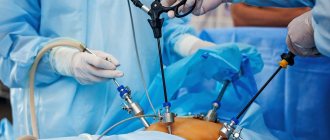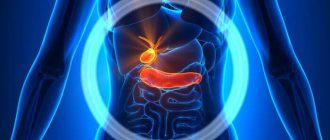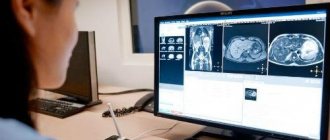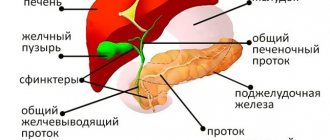Laparoscopic cholecystectomy is a minimally invasive operation to remove the gallbladder, which is considered the gold standard for the treatment of all types and complications of gallstone disease. You can undergo the appropriate examination, preoperative preparation and surgical intervention at the Miracle Doctor clinic in Moscow. The specialists of our center have modern medical equipment and have extensive experience in performing laparoscopic operations.
Types of cholecystectomy
If therapeutic treatment of gallstones does not bring results or there are clear indications for surgical intervention, doctors at the Central Clinical Hospital of the Russian Academy of Sciences in Moscow will give recommendations on the choice of surgical method. This can be a classic open cholecystectomy, endoscopic gallbladder surgery, or surgery through a mini-access.
- Laparoscopic cholecystectomy is an intervention that is characterized by low surgical trauma, fast and fairly easy recovery. Instruments and a video camera are inserted through punctures in the abdominal wall. As a result of air injection, visibility is provided for carrying out the necessary operations. In some cases, upon completion of the operation, the doctor ensures drainage of fluid from the subhepatic space. After 2-3 days, the patient leaves the department on his own and recovers at home.
- Operation from a mini access (3-7 cm incision) - the objective desire of most patients is to undergo laparoscopic cholecystectomy of the gallbladder. However, this type of surgical treatment is not suitable for all clinical cases. In order to reduce the degree of trauma during gallbladder removal, a decision may be made to perform the operation from a mini-access under the right costal arch - this is a compromise option between traditional abdominal surgery and laparoscopic surgery.
If you are indicated for a planned operation (laparoscopic cholecystectomy), contact the specialists of the Central Clinical Hospital of the Russian Academy of Sciences. In a modern hospital, we carry out any operations to remove the gall bladder at a high level - single-port, retrograde (from the neck), antegrade (from the fundus). You can find out the cost of the operation in the price list on the clinic’s website. However, it is better to obtain all information about the assessment and recommendations for the type directly at the consultation of specialists from the Central Clinical Hospital.
Laparoscopic cholecystectomy is a minimally invasive operation to remove the gallbladder using laparoscopic technology through a centimeter incision. Today this is the only method of planned treatment of chronic cholecystitis.
The operation is considered the most frequently performed of all those performed on internal organs.
Contraindications to laparoscopy
Contraindications to laparoscopy include the following:
- decompensated hypertension, accompanied by hypertensive crises;
- decreased blood clotting, hemophilia.
- decompensated respiratory failure;
- significant bloating,
- ventral hernias with a tendency to strangulate;
- abdominal abscesses;
- the presence of a large number of fistulas and scars of the anterior abdominal wall.
If you are wondering where to have laparoscopic surgery in Moscow, contact the Clinical Hospital on Yauza. Our specialists will conduct a thorough diagnosis and, if necessary, perform surgical intervention.
Indications for laparoscopic surgery
First, a decision is made about the need for surgery, and then a technique is selected. Currently, the use of laparoscopic techniques is considered justified for patients of any age, even if they are overweight.
Laparoscopic cholecystectomy is indicated for the following diseases:
- Cholecystitis that cannot be treated with conservative methods;
- Gallbladder cholesterosis;
- Cholecystitis in the acute stage;
- Asymptomatic cholecystolithiasis;
- Tumors of the gallbladder (including papillomas).
If the disease is accompanied by pain, patients are not surprised by the scheduled operation.
When the disease is asymptomatic and detected by chance, surgical treatment is also recommended. In this case, the operation is easier to tolerate.
With this diagnosis, the development of papillomas - benign tumors - is possible, so the operation begins with a detailed examination of the cavity for tumor growth. If there are doubts about the benign quality of the formation, a transition is made from laparotomy to an open type of surgical intervention - abdominal surgery.
Why is stenting done?
Only 20% of patients with liver, bile duct and pancreatic cancer undergo radical surgery to remove the tumor. For the rest, only palliative treatment is indicated. Even after radical surgery, cancer recurs in most patients.
One of the main goals of palliative treatment is to eliminate or prevent the development of obstructive jaundice. To do this, it is necessary to ensure normal outflow of bile. This goal can be achieved in two ways:
- surgical operations aimed at creating a bypass for the outflow of bile into the intestines;
- minimally invasive procedures to restore the patency of the bile ducts and prevent recurrent tumor stenosis.
Bile duct stenting is a minimally invasive treatment method that allows many patients to avoid major surgery.

9500 patients annually
- We accept patients 24/7
- Stabilization, resuscitation, medical care
Call me back!
When is laparotomy cholecystectomy inappropriate?
Absolute contraindications:
- Poor blood clotting;
- Pathology of vital functions in the stage of decompensation;
- The patient is in critical condition.
Relative contraindications are determined, as a rule, by the availability of modern equipment at the clinic, the individual characteristics of the patient and the experience of the surgeon. The question of using the technique is a joint decision of the surgeon and anesthesiologist.
There are situations when it is not possible to perform an operation due to anatomical abnormalities or an inflammatory process. In these cases, open surgery is performed.
Stent options
Plastic or metal stents are used for stenting. Plastic ones are rarely used and are temporary. They have a short lifespan due to the formation of bacterial biofilms and the deposition of bile salt stones.
Metal stents are available with or without coating. Uncoated stents are short-lived: tumor tissue grows through the cells of the stent and re-blocks the bile ducts. As a result, jaundice may develop again within a few weeks.
The NACFF clinic uses self-expanding nitinol stents with a polymer coating. It is inserted folded, and inside the bile ducts the stent expands and its diameter increases by 3-4 times. This is important to ensure the duration of the effect: the larger the diameter, the lower the risk of recurrent tumor obstruction. Since the stent is a cellular structure, a tumor can grow through the cells. To avoid this phenomenon, stents are covered with a thin film of polyurethane, silicone or polyethylene.
Stents with an antireflux mechanism are considered the best. They have a valve that prevents intestinal contents from entering the bile ducts. More than half of these stents remain functional 1 year after placement.
Average time of functioning of different types of stents before the development of tumor obstruction:
- plastic – 3.5 months;
- metal without coating – 5 months;
- covered stents – 10 months;
- partially covered with an antireflux mechanism – 15 months.
Doctors select the length and diameter of the stent individually, depending on the extent and location of the stricture (area of narrowing of the duct). Proper sizing reduces the risk of stent migration after placement.
Preparation period
An examination is carried out to assess the condition of the body and identify concomitant diseases:
- Physical examination:
- Blood and urine tests;
- Ultrasound of internal organs;
- ECG;
- X-ray or fluorography of the chest;
- Examination by doctors;
- Esophagogastroduodenoscopy.
This list can be expanded to include colonoscopy, MRI and endoscopic retrograde cholangiopancreatography.
In addition, it is necessary:
- Introduce only light foods into the menu in advance;
- Give a cleansing enema twice before surgery - in the evening and in the morning;
- If necessary, espumisan may be prescribed;
- Take a shower.
All medications are taken only in consultation with a doctor.
Stenting options
In medicine, two types of stenting are used, depending on the surgical approach:
- endoscopic (retrograde) stenting – performed through the duodenum (instruments are inserted into it through the oral cavity);
- percutaneous (antegrade) stenting - through a puncture in the abdomen.
In some cases, both accesses are used at once.
Stent installation techniques are not competitive, but complementary. In different situations, one method or another may be preferable.

Our expert in this field:
Ivanov Anton Alexandrovich
Medical director, oncologist-surgeon, candidate of medical sciences
Call the doctor
Call the doctor
Progress of the operation
Laparotomy cholecystectomy is performed under general anesthesia and lasts approximately 40 minutes. The steps of the procedure are as follows:
- Carbon dioxide is injected into the abdominal cavity.
- Tubes with valves are inserted so that instruments can be inserted without releasing gas, and a tube with a video camera - a laparoscope. The monitors reflect the progress of the operation with multiple magnification.
- Trocars are installed.
- The gallbladder is held with special instruments and the duct and artery are clamped with clips.
- The gallbladder is separated and removed.
- The abdominal cavity is drained.
Gallbladder removal surgery
The patient is put into a state of deep sleep using general anesthesia.
The doctor makes several punctures in the abdominal cavity, through which trocars are inserted - small hollow tubes with a diameter of about 2 cm. Carbon dioxide is injected through one of them, a video camera and a lighting device are inserted through the second, and surgical instruments are inserted through the third and fourth.
First, the doctor performs an examination of the abdominal cavity, paying special attention to the liver and gallbladder. By injecting gas, a working space is created for the operation.
During laparoscopy, the gallbladder is carefully removed from the liver bed and brought out through one of the punctures.
The doctor examines the patient's abdominal cavity again. If there are bleeding vessels, they are carefully coagulated. After this, the trocars are removed, and the punctures in the abdominal wall are sutured. If necessary, drainage is removed through one of the punctures.
Rehabilitation after surgery
Laparoscopy of the gallbladder lasts about 40 minutes, after which the doctor places self-absorbing sutures on the punctures. The patient will have to stay in the intensive care unit under the supervision of medical staff for 3–4 hours. After the anesthesia wears off, the operated person is transferred to a hospital.
- Absolute rest is required for the first 4–5 hours after surgery. You cannot eat, drink or try to get up.
- After about 6 hours, you are allowed to drink water in small portions at intervals of 10 minutes.
- Eating is possible a day after surgery.
- On the second day after removal of the gallbladder, you can get out of bed under the supervision of medical staff.
- On the third day, independent movement around the ward is allowed.
Approximately 10 to 14 days after surgery, the patient can return to work, but complete rehabilitation takes about a month. This must be remembered, even if the operated person does not experience pain and feels well. For successful recovery, it is recommended to follow these rules:
- the first 2 weeks, hard physical labor and sports are prohibited;
- You must abstain from sexual intercourse for a month;
- Constipation should not be allowed, so after surgery you should follow diet No. 5;
Compliance with these rules will allow you to return to a full life within six months. To ensure the speedy healing of stitches, you can attend physiotherapy.
Possible complications
Laparoscopic cholecystectomy is a low-traumatic operation, however, it must be performed by qualified doctors. According to statistics, 1% of people undergoing surgery experience complications, which can be caused not only by the individual characteristics of the body, but also by the actions of the surgeon. Among the negative consequences of the operation are:
- bleeding and abscesses in the abdominal cavity;
- damage to the bile ducts during the procedure;
- exacerbation of pancreatitis;
- vascular thrombosis;
- allergic reactions;
- suppuration of sutures, etc.
In order to avoid this, you need to choose a reliable medical institution with a good reputation.
Rehabilitation
The patient spends the first postoperative hours in intensive care, then he is transferred to the ward. After a few hours you can get up. The drainage is removed the next day. Recovery takes place within a month after surgery:
- You need to follow a daily routine;
- Take prescribed medications.
- Gradually introduce physical activity.
The need to follow a diet exists only in the first months after surgery, while the body adapts to new conditions. Within six months the restrictions will be lifted.
Speaking about the results of laparotomy cholecystectomy, it is worth noting that the operation is considered the standard treatment method. The main advantage is rapid recovery. The technique is safe, the frequency of conversions to open surgery is minimal.
Drug treatment and gymnastics
After removal of the gallbladder, it is vital to restore normal functioning of the body and adapt all systems. To do this, the doctor will select individual drug therapy for you, consisting of choleretic and enzyme drugs, as well as drugs that restore intestinal microflora. Several months after surgery, physical activity is necessary. Several months after surgery, physical activity is necessary. Take half-hour walks every day and do gymnastics in the morning. This will help saturate the body with oxygen and activate the abdominal organs.
Reviews
Almost all reviews from our patients are positive - the operation is considered effective, fast and low-traumatic. Unpleasant points that patients pay attention to:
- Abdominal pain due to bloating;
- Difficulty breathing because the lungs have been compressed;
- You have to fast at first.
All these sensations pass quickly. Operated patients agree that these symptoms can be tolerated; they are incomparable to the benefits of surgery.
Advantages of laparoscopy at the Yauza Clinical Hospital
- Doctors. Experienced, highly qualified surgeons with extensive experience in diagnostic and therapeutic laparoscopy.
- Modern equipment. The Clinical Hospital on Yauza is equipped with equipment from the world's leading manufacturers - Karl Storz, Covidien, Erbe, etc.
- Safety. Minimal risks of bleeding and complications.
- Innovative design of operating rooms. Infection-resistant seamless monolithic blocks, 5 levels of sterility, thanks to a complex ventilation system.
- Low morbidity. Absence of significant postoperative scars and pain.
- Fast recovery. The length of stay in the hospital is no more than a day. The recovery period is 2 times shorter compared to abdominal surgery.
- Only positive patient reviews about laparoscopy. Patients who underwent laparoscopy in our hospital are satisfied with the results.
- Good cosmetic result. After the laparoscopy procedure, there are no scars left on the skin.
We work seven days a week, service in two languages: Russian, English. Leave your phone number and we will call you back.
- About the center
- Doctors
- Branches and services
- Programs
- Stock
- Prices
- Contacts
st.
Volochaevskaya 15, building 1 Rimskaya, Pl. Ilyich, from 8:00 to 21:00 Site map About actions in case of fire © 2021. LLC "Clinical Hospital on the Yauza". LICENSE No. LO-77-01-016723 Processing of personal data Policy for the processing and protection of personal data Regulations on anti-corruption policy Rules for the provision of medical services
- Reviews Ask a question Make an appointment
- +7 Write to us
© 2021. LLC Clinical Hospital on Yauza. LICENSE No. LO-77-01-016723 Processing of personal data
Where to go
You can get stenting of the bile ducts at the NACFF clinic. Several reasons why you should contact our center:
- the best stents are used, which have a long service life and are highly likely not to require replacement in the future;
- three-dimensional reconstruction of the biliary tract using CT – allows you to ideally plan the procedure and choose the best stenting option;
- if necessary, treatment is carried out in two stages to reduce the risk of complications: stenting is performed after biliary decompression;
- our surgeons use both endoscopic and percutaneous stenting, as well as their combination, which allows us to choose the best option for each patient;
- individual choice of bile secretion methods, depending on the type of cancer, location and size of the tumor, anatomy of the bile and pancreatic ducts;
- There are other cancer treatments available that complement bile duct stenting, prolong the patient's life expectancy, prevent complications, and reduce symptoms.
Send documents by email The possibility of treatment will be considered by the chief physician of the clinic Anton Aleksandrovich Ivanov, oncologist-surgeon, kmn
At the NACFF clinic, procedures are performed by experienced specialists. They have already successfully performed hundreds of bile duct stenting operations.










